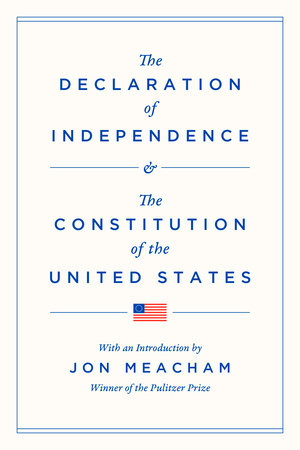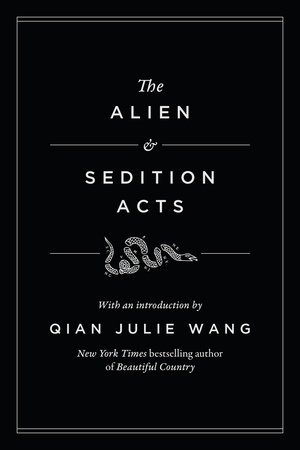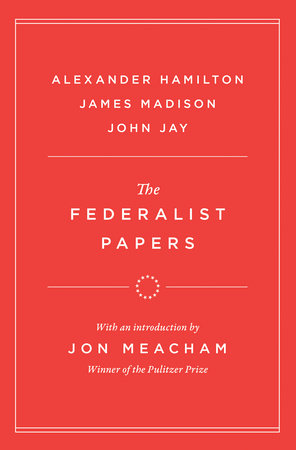Excerpt
The Declaration of Independence and the Constitution of the United States
IntroductionBy Jon Meacham
Everything seemed to be coming apart. It was the winter of 1860–61, and the American South was greeting the November election of Abraham Lincoln with secession, imperiling the Union. Watching from his home in Springfield, Illinois, Lincoln returned in his mind to the first principles of the nation he was now charged with saving. He was, interestingly, in correspondence with Alexander Stephens of Georgia, with whom he had served in Congress in the 1840s and who would soon become the vice president of the Confederacy. “You think slavery is right and ought to be extended; while we think it is wrong and ought to be restricted,” Lincoln wrote Stephens on Saturday, December 22, 1860. “That I suppose is the rub.”
Stephens was representative of a white South that felt surrounded, powerless, judged. The North, he believed, had become rabid about slavery. “When men come under the influence of fanaticism, there is no telling where their impulses or passions may drive them,” Stephens replied to Lincoln. “This is what creates our discontent and apprehensions. . . . A word fitly spoken by you now would be like ‘apples of gold in pictures of silver.’ ” The phrase was from the book of Proverbs, and Stephens wanted reassurance (a “word fitly spoken”) that Lincoln would allow slavery to endure and even grow.
Lincoln considered the verse in a different light. In a set of private notes, the president-elect wrote that America’s “apple of gold”—its most valuable asset—was the Declaration of Independence, the charter drafted, approved, and promulgated in the summer of 1776. The country’s “picture of silver”—the essential frame in which the apple of gold could rest—was the Constitution, the governing document written in 1787, ratified in 1788, and put fully into operation in 1789. “Without the Constitution and the Union, we could not have attained” our national greatness, Lincoln wrote; “but even these are not the primary cause of our great prosperity. There is something back of these, entwining itself more closely about the human heart. That something, is the principle of ‘Liberty to all’—the principle that clears the path for all—gives hope to all—and, by consequence, enterprise, and industry to all.” As Lincoln saw it, he could not retreat from the conviction that slavery was ultimately incompatible with the spirit of the Declaration of Independence. “As I would not be a slave, so I would not be a master,” Lincoln remarked. “This expresses my idea of democracy.”
Such thoughts were vital in Lincoln’s cataclysmic hour, and they are vital today. If America is to be America, the foundational documents reprinted here must be not theoretical but tactile, not quaint but vivid, not dead but alive. For all our faults, for all our dreams deferred and our unfulfilled promises, the United States of America is founded not on ethnicity but on an ideal. This is not a sentimental patriotic point; it is a statement of fact. History tells us that we can chart our national progress in terms of how close we come to, or how far we fall from, realizing the implications of the Declaration and accordingly interpreting or amending our Constitution—and ourselves.
Lincoln went to Washington determined to preserve the apple of gold within its picture of silver. Through storm and strife and blood and fire he rescued the American project. To understand that project, and why he fought for its survival, we must begin at the beginning.
•
On Friday, June 7, 1776, Richard Henry Lee of Virginia rose in the Second Continental Congress to propose a resolution “that these united colonies are and of right ought to be free and independent states.” Lee’s motion had been a long time coming. The end of the Seven Years’ War in 1763 had left Britain in a powerful position in North America, but empires are expensive things. About ten thousand British troops were deployed to defend British North America against French and Native American forces. To London, asking the colonists to bear a measure of the burden was eminently reasonable, a view that led to clashes over taxation, control of Western lands, and sea traffic. “The Americans have made a discovery, or think they have made one, that we mean to oppress them,” the Anglo-Irish statesman Edmund Burke remarked in 1769. “We have made a discovery, or think we have made one, that they intend to rise in rebellion. . . . We know not how to advance; they know not how to retreat.” In April 1775, blood was shed at Lexington and Concord. In August, King George III issued a “Proclamation for Suppressing Rebellion and Sedition,” asserting that the Americans were in “open and avowed rebellion.” In November the royal governor of Virginia, Lord Dunmore, offered liberty to any enslaved person who took up arms against the rebels. Then came devastating May 1776 news that the king had hired mercenaries to help subdue his subjects.
It was in this charged climate that Richard Henry Lee offered his resolution. The Congress authorized a small committee to draft a declaration—Benjamin Franklin of Pennsylvania, John Adams of Massachusetts, Roger Sherman of Connecticut, Robert Livingston of New York, and Thomas Jefferson of Virginia. The main drafting fell to Jefferson; he undertook it, he recalled, to make the thinking of “the American mind” clear to a watching world. Writing in his redbrick boardinghouse at Seventh and Market streets in Philadelphia, Jefferson drew on Locke, Montesquieu, and the philosophers of the Scottish Enlightenment. James Wilson’s pamphlet Considerations on the Nature and Extent of the Legislative Authority of the British Parliament and the Virginia Declaration of Rights, written by George Mason, were also influential.
In retrospect the Declaration would take on eternal significance. In real time, however, Jefferson, writing quickly in a crowded hour, saw the Declaration in practical terms. The task, he recalled, was “to place before mankind the common sense of the subject” in “terms so plain and firm as to command . . . assent, and to justify ourselves in the independent stand we [felt] compelled to take. . . . All its authority rests then on the harmonizing sentiments of the day, whether expressed in conversation, in letters, printed essays or in the elementary books of public right, as Aristotle, Cicero, Locke, Sidney Etc.” By the end of his life, Jefferson would come to see the Declaration as something akin to scripture. He had written his draft on a mahogany lap desk of his own design that he gave to the husband of a granddaughter in 1825, observing: “Politics as well as Religion has its superstitions. These, gaining strength with time, may, one day, give imaginary value to this relic, for its great association with the birth of the Great Charter of our Independence.” The ordinary had become sacred.
The document was ratified on Thursday, July 4, 1776, and the news of independence was announced on the following Monday, July 8, in front of the Pennsylvania State House. In the streets, a crowd cheered: “God bless the free states of North America.”
To encounter the Declaration of Independence is to be plunged back into a complex political world. By the 1770s, the English Civil War, the Restoration, and the Glorious Revolution had shaped the American view of power. In Britain in the seventeenth century, the people, including many aristocrats, had rebelled against the absolutism of the Stuart kings, leading to chaos. There was the execution of Charles I, the commonwealth under Oliver Cromwell, the Restoration of the Stuarts (which led to more political and religious strife), and finally the Glorious Revolution of 1688–89, when William of Orange and his wife, Mary, were crowned to preside over a constitutional ethos based on a Declaration of Rights that limited the monarchy’s power. The Parliament, “full and free,” would be supreme, with guaranteed elections and limitations on the state’s power to encroach on individual rights.
Which was essentially what the American colonists wanted: the full benefits of Englishmen, including representation in Parliament. And the denial of these rights drove much of the Declaration, which included twenty-seven grievances. These sections made up the largest portion of a document intended to convince particular audiences—wavering colonists, soldiers, potential foreign allies—of the rightness of the American cause. Congress ordered that the Declaration be distributed “to the several assemblies, conventions and committees, or councils of safety, and to the several commanding officers of the continental troops; that it be proclaimed in each of the United States, and at the head of the army.”
One part of Jefferson’s draft did not survive the collective (and, to the sensitive Jefferson, anguishing) editing of the Congress: a denunciation of slavery. “The clause . . . reprobating the enslaving [of] the inhabitants of Africa, was struck out in complaisance to South Carolina & Georgia who had never attempted to restrain the importation of slaves, and who on the contrary still wished to continue it,” Jefferson noted. “Our Northern brethren also I believe felt a little tender under those censures; for tho’ their people have very few slaves themselves yet they had been pretty considerable carriers of them to others.”






